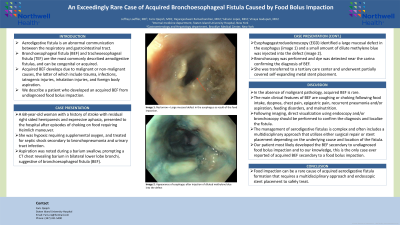Tuesday Poster Session
Category: Esophagus
P3973 - An Exceedingly Rare Case of Acquired Bronchoesophageal Fistula Caused by Food Bolus Impaction
Tuesday, October 29, 2024
10:30 AM - 4:00 PM ET
Location: Exhibit Hall E

- JL
Jeffrey Loeffler, MD
Staten Island University Hospital
Staten Island, NY
Presenting Author(s)
Jeffrey Loeffler, MD1, Faris Qaqish, MD2, Rajarajeshwari Ramachandran, MD3, Yuhann Lopez, MD4, Vinaya Gaduputi, MD4
1Staten Island University Hospital, Staten Island, NY; 2Staten Island University Hospital, Northwell Health, Staten Island, NY; 3Fresno Veterans Affairs Medical Center, Fresno, CA; 4Blanchard Valley Health System, Findlay, OH
Introduction: Aerodigestive fistula is an abnormal communication between the respiratory and gastrointestinal tract. Bronchoesophageal fistula (BEF) and tracheoesophageal fistula (TEF) are the most commonly described aerodigestive fistulas, and can be congenital or acquired. Acquired BEF develops due to malignant or non-malignant causes, the latter of which include trauma, infections, iatrogenic injuries, inhalation injuries, and foreign body aspiration. We describe a patient who developed an acquired BEF from undiagnosed food bolus impaction.
Case Description/Methods: A 68-year-old woman with a history of stroke with residual right sided hemiparesis and expressive aphasia, presented to the hospital after episodes of choking on food requiring Heimlich maneuver. She was hypoxic requiring supplemental oxygen, and treated for septic shock secondary to bronchopneumonia and urinary tract infection. Aspiration was noted during a barium swallow, prompting a CT chest revealing barium in bilateral lower lobe bronchi, suggestive of bronchoesophageal fistula (BEF). Esophagogastroduodenoscopy (EGD) identified a large mucosal defect in the esophagus (image 1) and a small amount of dilute methylene blue was injected into the defect (image 2). Bronchoscopy was performed and dye was detected near the carina confirming the diagnosis of BEF. She was transferred to a tertiary care center and underwent partially covered self-expanding metal stent placement.
Discussion: In the absence of malignant pathology, acquired BEF is rare. The main clinical features of BEF are coughing or choking following food intake, dyspnea, chest pain, epigastric pain, recurrent pneumonia and/or aspiration, feeding disorders, and malnutrition. Following imaging, direct visualization using endoscopy and/or bronchoscopy should be performed to confirm the diagnosis and localize the fistula. The management of aerodigestive fistulas is complex and often includes a multidisciplinary approach that utilizes either surgical repair or stent placement depending on the underlying cause and location of the fistula. Our patient most likely developed the BEF secondary to undiagnosed food bolus impaction and to our knowledge, this is the only case ever reported of acquired BEF secondary to a food bolus impaction.

Disclosures:
Jeffrey Loeffler, MD1, Faris Qaqish, MD2, Rajarajeshwari Ramachandran, MD3, Yuhann Lopez, MD4, Vinaya Gaduputi, MD4. P3973 - An Exceedingly Rare Case of Acquired Bronchoesophageal Fistula Caused by Food Bolus Impaction, ACG 2024 Annual Scientific Meeting Abstracts. Philadelphia, PA: American College of Gastroenterology.
1Staten Island University Hospital, Staten Island, NY; 2Staten Island University Hospital, Northwell Health, Staten Island, NY; 3Fresno Veterans Affairs Medical Center, Fresno, CA; 4Blanchard Valley Health System, Findlay, OH
Introduction: Aerodigestive fistula is an abnormal communication between the respiratory and gastrointestinal tract. Bronchoesophageal fistula (BEF) and tracheoesophageal fistula (TEF) are the most commonly described aerodigestive fistulas, and can be congenital or acquired. Acquired BEF develops due to malignant or non-malignant causes, the latter of which include trauma, infections, iatrogenic injuries, inhalation injuries, and foreign body aspiration. We describe a patient who developed an acquired BEF from undiagnosed food bolus impaction.
Case Description/Methods: A 68-year-old woman with a history of stroke with residual right sided hemiparesis and expressive aphasia, presented to the hospital after episodes of choking on food requiring Heimlich maneuver. She was hypoxic requiring supplemental oxygen, and treated for septic shock secondary to bronchopneumonia and urinary tract infection. Aspiration was noted during a barium swallow, prompting a CT chest revealing barium in bilateral lower lobe bronchi, suggestive of bronchoesophageal fistula (BEF). Esophagogastroduodenoscopy (EGD) identified a large mucosal defect in the esophagus (image 1) and a small amount of dilute methylene blue was injected into the defect (image 2). Bronchoscopy was performed and dye was detected near the carina confirming the diagnosis of BEF. She was transferred to a tertiary care center and underwent partially covered self-expanding metal stent placement.
Discussion: In the absence of malignant pathology, acquired BEF is rare. The main clinical features of BEF are coughing or choking following food intake, dyspnea, chest pain, epigastric pain, recurrent pneumonia and/or aspiration, feeding disorders, and malnutrition. Following imaging, direct visualization using endoscopy and/or bronchoscopy should be performed to confirm the diagnosis and localize the fistula. The management of aerodigestive fistulas is complex and often includes a multidisciplinary approach that utilizes either surgical repair or stent placement depending on the underlying cause and location of the fistula. Our patient most likely developed the BEF secondary to undiagnosed food bolus impaction and to our knowledge, this is the only case ever reported of acquired BEF secondary to a food bolus impaction.

Figure: Image 1: EGD image showing a large mucosal defect in the esophagus (black arrow)
Image 2: EGD image after injection of methylene blue into the esophageal mucosal defect
Image 2: EGD image after injection of methylene blue into the esophageal mucosal defect
Disclosures:
Jeffrey Loeffler indicated no relevant financial relationships.
Faris Qaqish indicated no relevant financial relationships.
Rajarajeshwari Ramachandran indicated no relevant financial relationships.
Yuhann Lopez indicated no relevant financial relationships.
Vinaya Gaduputi indicated no relevant financial relationships.
Jeffrey Loeffler, MD1, Faris Qaqish, MD2, Rajarajeshwari Ramachandran, MD3, Yuhann Lopez, MD4, Vinaya Gaduputi, MD4. P3973 - An Exceedingly Rare Case of Acquired Bronchoesophageal Fistula Caused by Food Bolus Impaction, ACG 2024 Annual Scientific Meeting Abstracts. Philadelphia, PA: American College of Gastroenterology.
